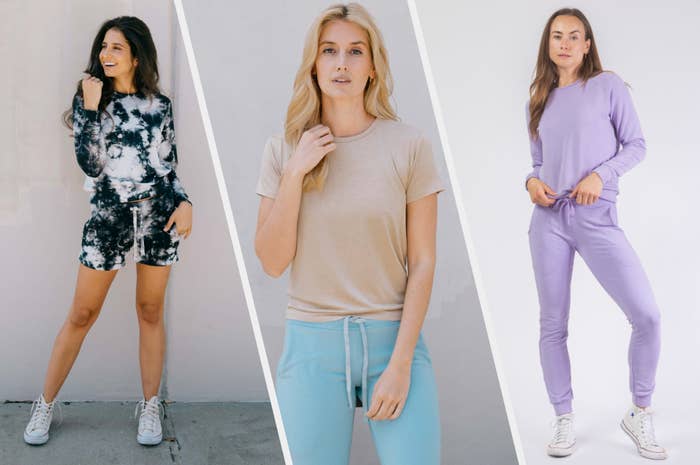Common Fabric Types Used in Branded Clothing and What They Mean
Common Fabric Types Used in Branded Clothing and What They Mean
Blog Article
The Importance of Lasting Apparel: Exactly How It Impacts the Setting and Your Closet
Sustainable clothes is progressively recognized for its critical duty in decreasing the environmental effect of the rapid fashion business. By concentrating on green materials and honest manufacturing methods, it deals with pushing environmental concerns. This shift not only benefits the world however likewise influences customer choices, resulting in a more thoughtful strategy to wardrobe management. Comprehending these dynamics raises crucial concerns about style's future and personal responsibility in shaping it.
The Ecological Impact of Quick Fashion

Benefits of Lasting Materials
Lasting materials offer significant benefits, specifically with environment-friendly fabric options that lessen environmental harm. These materials also show longevity and long life, reducing the demand for regular replacements. Because of this, they add to a more sustainable fashion business and advertise responsible customer actions.
Eco-Friendly Textile Selections
While the apparel industry has actually long been connected with rapid trends and environmental injury, the rise of eco-friendly material selections offers a transformative chance. Lasting products such as natural cotton, hemp, and Tencel have actually acquired appeal because of their lower ecological impact. These materials are commonly produced without damaging chemicals and require much less water, reducing their carbon footprint - Branded Clothing. Furthermore, several environmentally friendly textiles are naturally degradable, adding to a round economic situation by reducing waste. Picking lasting products not only supports eco liable methods however additionally promotes healthier ecological communities. As consumers become more knowledgeable about their purchasing power, the demand for eco-friendly textiles motivates brand names to innovate and take on more sustainable production methods, eventually profiting the world and future generations
Toughness and Durability Benefits
Numerous consumers are progressively identifying the longevity and long life benefits of lasting products in their clothes options. Unlike conventional textiles, lasting products such as natural cotton, hemp, and recycled polyester are engineered to endure wear and tear, resulting in garments that last longer. This minimized frequency of substitute not only saves customers money with time however additionally reduces waste created by quick style. In enhancement, lasting clothing frequently employs environmentally friendly manufacturing approaches that boost fabric stamina, adding to a decrease in the general carbon footprint. By buying durable apparel, customers can cultivate a more sustainable closet while taking pleasure in top notch items that keep their visual and functionality with time. Consequently, longevity and long life stand as vital benefits of picking lasting products.
Minimizing Waste Via Sustainable Practices
Minimizing waste in the apparel industry can be attained via cutting-edge practices such as upcycling and repurposing products. Furthermore, adopting minimalist closet methods motivates customers to focus on high quality over amount, eventually lowering clothing intake. Together, these approaches contribute considerably to a much more lasting garments design.
Upcycling and Repurposing Materials
Upcycling and repurposing products have actually become cutting-edge approaches in the apparel industry, transforming disposed of fabrics right into useful new items. This approach not just reduces waste but additionally encourages creativity and uniqueness in garments style. By taking old garments and materials, developers can create unique items that show individual design while lowering the need for brand-new sources. Furthermore, upcycling usually requires less energy and water contrasted to standard manufacturing procedures, considerably reducing the environmental impact of fashion. As customers end up being a lot more knowledgeable about sustainability, the popularity of upcycled garments remains to rise, promoting a round economic climate. Eventually, these techniques add to a much more lasting future, where style focuses on ecological health over quick production and intake.

Minimal Closet Strategies
As individuals increasingly seek to decrease their environmental impact, taking on minimal wardrobe methods has obtained traction as a reliable method to sustainable style. These techniques highlight high quality over quantity, encouraging customers to curate a smaller sized collection of versatile, durable garments. By concentrating on classic items that can be combined and matched, people can reduce the frequency of acquisitions and inevitably reduce waste.Additionally, minimalism promotes mindful usage, prompting consumers to assess the moral and environmental implications of their options. This approach not just cultivates a much more sustainable way of living yet additionally streamlines everyday decision-making pertaining to outfit. As people embrace minimal concepts, they add to a fashion society that values sustainability and liable consumerism, inevitably causing an extra eco-conscious society.
The Role of Moral Labor in Sustainable Style
While several customers are progressively familiar with the environmental effects of their garments choices, the significance of moral labor practices in lasting fashion can not be overlooked. Honest labor encompasses fair incomes, safe working problems, and regard for workers' legal rights, creating the backbone of accountable fashion production. Brand names that prioritize honest labor not only uplift communities but also set a criterion for responsibility in the industry.Moreover, the assimilation of ethical methods cultivates openness, enabling customers to make educated options concerning their purchases. This method contrasts greatly with quick style's unscrupulous labor models, which commonly focus on revenue over individuals. By supporting firms dedicated to honest labor, consumers contribute to a system that values human dignity together with ecological sustainability. Ethical labor is not merely an add-on; it is crucial to the more comprehensive goal of sustainable style, guaranteeing that the mission for eco-friendliness does not come at the cost of human legal rights.
The Impact of Lasting Apparel on Carbon Emissions
Lasting garments has the prospective to significantly decrease carbon emissions connected with the fashion industry. Typical garment manufacturing contributes notably to greenhouse gas emissions, largely due to energy-intensive production processes and making use of non-renewable sources. In contrast, sustainable fashion concentrates on environmentally friendly materials, such as natural cotton or recycled fibers, which typically require much less energy to produce.Moreover, lasting brands tend to read the article take on more efficient manufacturing methods, lessening waste and reducing overall emissions. By focusing on toughness and ageless layout, lasting clothing motivates consumers to get less regularly, additional lowering the carbon impact connected with overconsumption.Additionally, many sustainable brand names are devoted to transparency in their supply chains, making it possible for customers to make informed selections that align with their worths. Ultimately, changing towards lasting apparel can lead to a considerable reduction in carbon emissions, adding to a healthier earth and a much more lasting future for the style industry.
Supporting Regional Economic Situations With Lasting Selections
The shift towards lasting clothing not only addresses ecological problems however additionally considerably benefits regional economic situations. By picking sustainable style, customers frequently support little businesses and local artisans, boosting area resilience. These enterprises usually operate a smaller scale, focusing on craftsmanship and moral practices over mass production.Investing in locally made sustainable garments promotes task development and promotes financial growth within areas. As customers come to be extra familiar with the ecological influence of their acquisitions, they increasingly look for products that reflect their values. This demand encourages local producers to adopt sustainable practices, adding to a round economy.Moreover, sustaining regional organizations lowers transport discharges, lining up with eco-conscious consumer behavior. The interconnectedness of sustainable clothes and local economic climates highlights the essential role that private choices play in promoting both economic and ecological wellness. By promoting these regional connections, communities can thrive while additionally functioning in the direction of a much more sustainable future.
Transforming Your Storage Room: Tips for a Sustainable Wardrobe
As individuals look for to minimize their ecological influence, transforming a closet right into a lasting wardrobe becomes a vital step. One reliable method is to examine existing clothes, keeping only items that are put on regularly which align with sustainability objectives. Prioritizing quality over amount is vital; purchasing resilient items from environmentally friendly brands can considerably minimize waste.Additionally, including used products can rejuvenate a closet while lessening ecological damages. Organizing apparel swaps with pals or contributing unused products can additionally advertise sustainability.When purchasing, people should look for materials that are organic, recycled, or biodegradable, and prevent rapid fashion sellers - Branded Clothing. Practicing mindful usage by thoughtfully taking into consideration each acquisition can contribute to a more sustainable lifestyle. By applying these ideas, one can develop a wardrobe that shows individual style while supporting environmental stewardship
Often Asked Inquiries
Exactly How Can I Recognize Sustainable Clothing Brands?
To identify sustainable garments brands, one ought to research materials utilized, inspect for accreditations like Fair Trade, and analyze the brand's transparency about their manufacturing processes, labor techniques, and environmental effect, making certain environment-friendly and ethical practices are prioritized.
What Are the Costs Associated With Lasting Fashion?
The prices connected with lasting fashion can vary considerably. Greater manufacturing expenses, moral sourcing, and environment-friendly materials commonly cause enhanced retail prices, which may hinder some customers while attracting ecologically conscious buyers.
Can Sustainable Clothing Be Fashionable and Stylish?
Sustainable garments can indeed be stylish and fashionable. Designers significantly focus on ingenious materials and moral production methods, verifying that style and sustainability can exist together. Consumers now have varied choices that blend aesthetic appeals with environmental awareness.
Just How Does Washing Clothing Affect Their Sustainability?
Washing clothing substantially discover this info here influences sustainability by consuming water and power, adding to air pollution, and triggering microplastic release. Constant cleaning can deteriorate materials, shortening their lifespan and boosting the need for replacements, eventually aggravating ecological worries.
What Is the Life-span of Sustainable Clothing Contrasted to Fast Style?
The lifespan of lasting apparel commonly surpasses that of fast fashion things, typically long-term a number of years due to high quality products and workmanship. In comparison, fast fashion garments might degrade quickly, demanding more regular substitutes. Sustainable apparel is progressively acknowledged for its critical duty in reducing the ecological impact of the quick fashion market. While lots of consumers are increasingly aware of the environmental repercussions of their clothes selections, the relevance of ethical labor techniques in lasting style can not be overlooked. Branded Clothing. Lasting apparel has the possible to greatly lower carbon exhausts linked with the style market. In contrast, sustainable fashion focuses on environment-friendly products, such as natural cotton or recycled fibers, which often Learn More Here require less energy to produce.Moreover, sustainable brands tend to adopt much more effective manufacturing practices, reducing waste and reducing general discharges. By prioritizing sturdiness and ageless style, lasting clothing urges customers to get less frequently, more lowering the carbon footprint associated with overconsumption.Additionally, numerous sustainable brands are dedicated to transparency in their supply chains, making it possible for customers to make educated choices that straighten with their values
Report this page